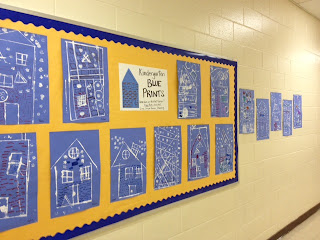In order to understand the principle of art, Balance, 2nd graders looked at various art reproductions and discussed the difference between Symmetry and Asymmetry.
It's common to think of insects when discussing something balanced because insects are so symmetrical. Check out this video of an
insect photographer who captures photographs of bugs up close and personal. Students were surprised to see the amount of color and detail.
We discussed common characteristics of insects, and students designed their own bug using lines, shapes, and colors. In order to create symmetry, students only drew half their bug and then monoprinted the other side.
After cutting out the insects and gluing to a clean paper background, students created a word border by writing about their insect around the outside edge of the paper.
I think it's interesting how each insect is completely different and unique. The students really explored their own ideas and own personal artistic choices in this project.




































